Living Data
Science Art & Talks
The experiential process of observation and reflection is key to art and science
and is an essential component in understanding interdependence
of all species and ecosystems, terrestrial and aquatic.
Paul Fletcher Animator
Science Art & Talks
Living Data Program for the 2013 Ultimo Science Festival, Sydney, September 12-21.
Light Responses Drawings, animations and objects by Lisa Roberts
A keystone species, Antarctic krill, is at risk from increasingly warm and acid oceans.
Art responses are made to the sciencethat predicts a future based on how we choose to live now.
Life! Death. 2013
Animation/video: Lisa Roberts
Music: Stephanie Cooper and Elyse Brown
Dance: Lisa Roberts, Margaret Bowman
Data: So Kawaguchi Australian Antarctic Division Bill Gladstone and Katherina Petrou,University of Technology, Sydney
Zhongnan Jia (Molly),Institute for Marine and Antarctic Studies
Exectutive production: Ken Wilson
Light Responses is a series of art works that combine scientific understandings with knowledge of our cellular, primal connections. As Mary E. White explains in the Big Picture(2012):
The first living cells (Bacteria with the power of self-replication and metabolism making them alive) were born in the hot "chemical soup" that was the Primaeval ocean nearly 4 billion years ago. Earth had cooled sufficiently by then from its molten, fiery beginnings to have liquid water - and Water and Life are inseparable. All Living things, in the Bacterial, Protist (including Algae), Fungal, Plant and Animal Kingdoms that evolved since then, including you and me, can trace an ancestry back to those first cells in an unbroken lineage on Life's Continuum.
Euphausia superba (Antarctic krill) 2013
Animation/video: Lisa Roberts
Music: Robert Cuckson
Questzalcoatl for flute and violin (2004)
Dance: Lisa Roberts, Margaret Bowman
Calligraphy: Vikki Quill
Motion capture: Jason Benedek
University of Technology, Sydney
Data: So Kawaguchi Australian Antarctic Division,
with Zhongnan Jia (Molly),Institute for Marine and Antarctic Studies
Exectutive production: Ken Wilson
Music program notes:
Quetzalcoatl for Flute and Violin (2004)
Quetzalcoatl is the name of the Aztec god, who, according to myth, transformed himself from a snake into a bird. In this piec, the flute, in F sharp major, and the violin, in A minor, not only play in different keys, but have separate material, the violin theme based on Gregorian chant, and the flute a series of decorative motives. As the piece progresses, each instrument acquires musical elements from the other. At the climax, they interchange roles and material and end as they began, but in inverted form.
The music was provided by choreographer Barbara Cuckson, sister of the composer, after I explained to her the nature of my project - to visualise transformation between human and krill forms, and a sense of cycling between life and death.
The idea for the animation started in Hobart in 2012 when I met Molly, a PhD student studying krill. When Molly described her microscopic images of krill embryos developing I was intrigued. How might her images relate to what I know about krill?. With her permission I made digital tracings of the images and sequenced them as an animation to show how an embryo grows. I projected the line animation through mesh screens and two dancers responded to its movements while holding red LED bike lights. I video recorded the performance, then edited the footage with the original tracings. I distorted some of the tracings to suggest views through water. Afterwards I recognised that the red of the bike lights resembled red patches in the original microscopic images. When I asked krill biologist So Kawaguchi what the red patches were he said they are the the krill's pigmentation, known as chromatophores.
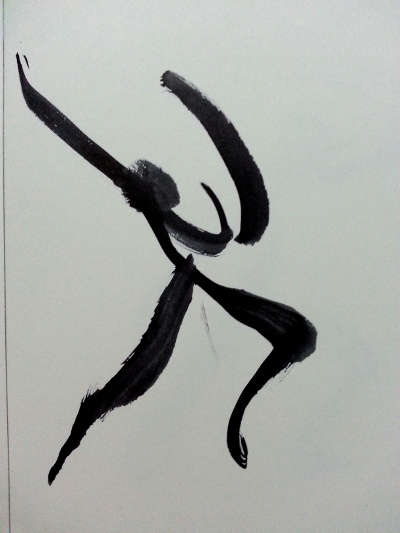
Lisa Roberts.
Rozelle Dancer Ink drawing on A4 paper
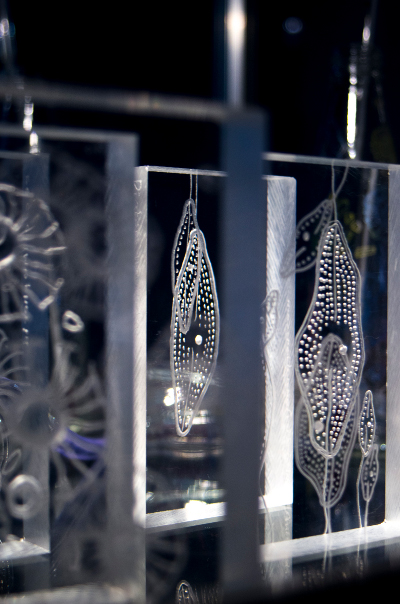
Lisa Roberts
Oceanic forms: Diatoms Navicular
Hand-engraved acrylic blocks,
each 120mmx65mmx30
Photo: Stephen Pierce
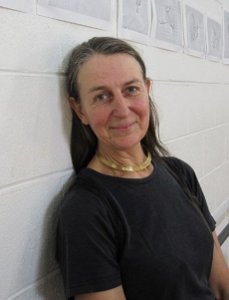
Notes for exhibition designers:
List of works
Drawings Drawing connections is a work that will evolve as drawings are made on A4 sheets of paper to trace gestures of connection between people and the exhibits. The drawings may join others made by gallery visitors who draw their own responses to the exhibition.
Animations for projecting through Biomesh screens:
Euphausia superba (Antarctic krill)
Living Data: Animating change
Life! Death
Oceanic reconnection
Polar Time
Euphausia superba (Antarctic krill), Living Data: Animating change, Life! Death and Oceanic reconnection will be screened as a sequence.
Polar Time, may be screened as a sequence with Ice Melt,and Polarity.
Objects Winning Party?
A discarded x-ray light-box illuminates acrylic blocks and disks, discarded trophies and party bling (see above).
The light box is 540mm wide, 395mm deep, 150mm high.
Each object is hand-engraved with human, krill and phytoplankton forms.
24 blocks are each 120mm x 65mm x 30mm.
Bling are oval in shape and variable in size, ranging from 40mm x 35mm to 70mm x 45mm. The acrylic disks are clear and coated on one side with a surface that reflects different colours depending on the angle of observation.
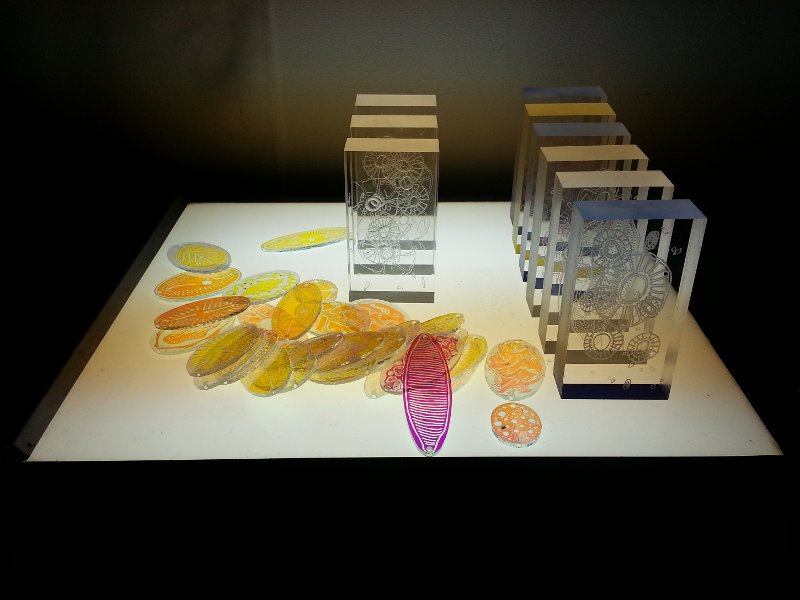
Lisa Roberts. Winning Party?
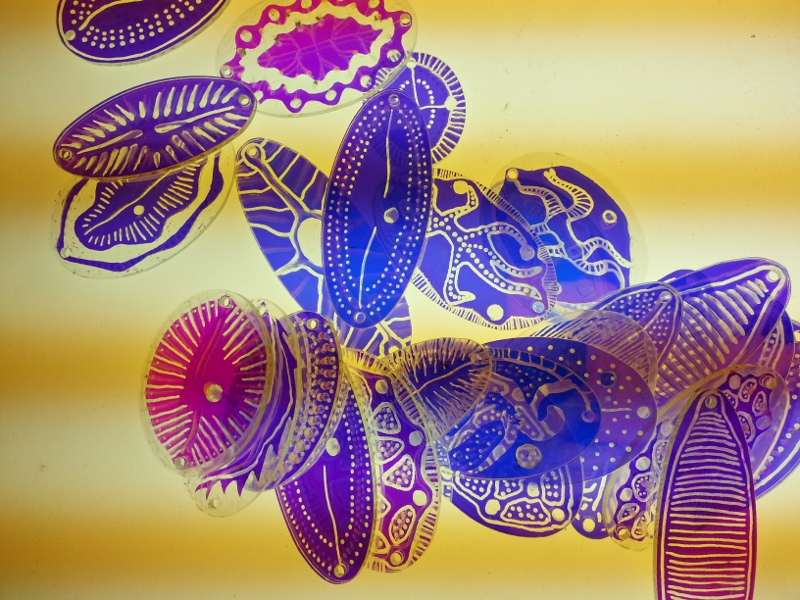
Lisa Roberts. Winning Party? Phyto Bling
PEER REVIEWS
Artist and curator Graham Howe suggests (Email Aug. 25 2013) that we consider vertical projection for animations. He writes, 'This is cool': Highlike Animations cast from a ceiling mounted projector onto the floor could make people feel they are walking over melting ice and ocean depths.
Choreographer Barbara Cuckson writes (Email Aug. 25 2013):
Here are just a few small thoughts:
People like to feel comfortable about understanding what it's all about (told what to think).
Should there be a more simple, direct 'mission' statement with each presentation?
Signs will be made and placed near each exhibit, using text at the start of each artist's page on this website. For example this text (at the top of this page) will appear as a sign near my work:
"A keystone species, Antarctic krill, is at risk from increasingly warm and acid Oceans.
Light and dark responses are made to the science that predicts a future based on how we choose to live now."
HOWEVER! Students working with us may question the sense of these signs, which may lead us to re-writing them more succinctly and objectively.
Are the items meant to invite responses?
Yes. Our aim is to stimulate curiosity about how the world works.
In sharing your own responses to varied subjects, are you actively going to collect or document if the viewer does participate ideas and thoughts?
Yes. Visitors will be invited to draw and write their ideas and thoughts.
Questions:
Why krill?
How big is a krill?
How many are there?
Where are they?
What is our connection with krill?
Could you exhibit a krill?
I can draw up a small take-away fact sheet about krill and place copies alongside flyers that artist have been invited to bring.
Yes! I can exhibit a krill. In 2013 I was working at the Australian Antarctic Division and scientist Geraldine Nash gave me a preserved specimen that she had set in clear acrylic. She had made some as gifts for visiting krill researchers. Here it is photographed on the light box:
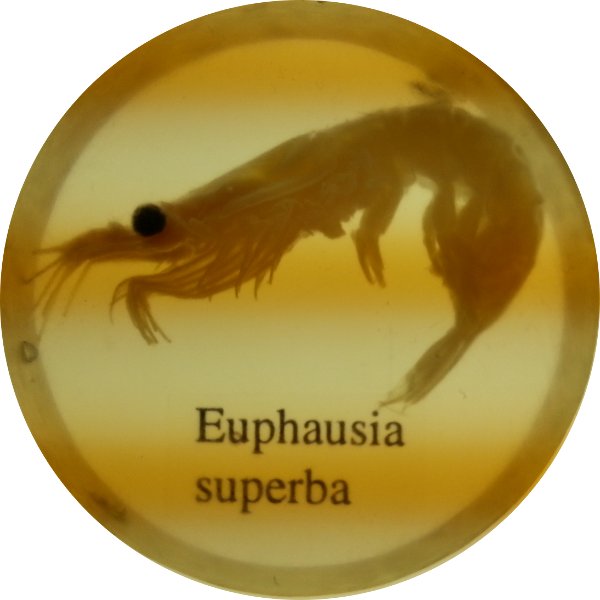
Geraldine Nash
Euphausia superba 2003
Preserved specimen set in acrylic disk
25mm diameter
To evaluate how reciprocity works in Living Data and how our program could be improved, I ask contributors,
What do you most value about our work?
What have you contributed?
How have you benefited?
How could our program be improved?
Jason Benedek, Electronic artist, University of Technology, Sydney
What do you most value about our work?
It provides an excellent opportunity to bring science and scientific data to a larger audience, and provides accessibility and fresh perspectives on climate change data and our environment.
What have you contributed?
Technical advice and expertise. Videography and editing. Tea.
How have you benefited?
I have made important new connections with artists and scientists and learnt a lot about the critical scientific issues facing the planet, and this has no doubt informed my own practice.
How could the Living Data program be improved?
More art! More science! More fora (forums?) More shared data and information. What a wonderful beginning!
Barbara Cuckson, Choreographer/Teacher, Rozelle School of Visual Arts
What do you most value about our work?
Providing a link between what is concrete and what is spiritual. Connecting and collecting and collating significant thoughts and materials.
What have you contributed?
Comments that are intuitive but honest, and being appreciative of the integrity of the work and those involved in it.
How have you benefited?
Enjoying the stimulation for my brain. Feeling connected with people I respect. Interested in the discoveries, large and small.
Living Data: Animating change
This work combines the animation presented at the 2012 Antarctic Treaty Consultative Meeting with original music composed by VOA (Benn DeMole & Catriona Davies) for Oceanic Sydney,a Living Data performance installation at Customs House, Sydney, with dancers Caterina Mocciola & Ashley Macqueen.











